 For the past 3,500 years, Mayan women have created intricate huipiles on a backstrap loom. These traditional garments signify the origin and status of the woman. Even today, with all those modern clothes, easily produced and bought, most women in Guatemala prefer to wear the traditional huipiles on a daily basis. But a lot of females are beginning to lose the real value and importance of this garment for their culture. And the reason for this disastrous change in priorities that can cause a total disappearance of Guatemalan traditional weaving (which takes its roots in Maya culture) is the recycling of huipiles and underpricing them.
For the past 3,500 years, Mayan women have created intricate huipiles on a backstrap loom. These traditional garments signify the origin and status of the woman. Even today, with all those modern clothes, easily produced and bought, most women in Guatemala prefer to wear the traditional huipiles on a daily basis. But a lot of females are beginning to lose the real value and importance of this garment for their culture. And the reason for this disastrous change in priorities that can cause a total disappearance of Guatemalan traditional weaving (which takes its roots in Maya culture) is the recycling of huipiles and underpricing them.
The huipil is a popular folk garment used by women in Guatemala, Mexico, and the neighboring countries. It is a loose-fitting tunic sewn from several pieces of woven cloth. Usually, the garment is sleeveless or has short sleeves. The weaving is made on a backstrap loom, and there are hundreds of various traditional patterns woven into the fabric (each geographical area has its own typical symbols and designs). The huipil is a very ornate and beautiful tunic that displays the rich culture of local people.
This is a story about huipiles. This is a story about the women who make them, the cultural significance they carry and stories they tell. This story is told by Erin Kökdil, the activist who is studying Maya traditions and the art and culture of Latin America.
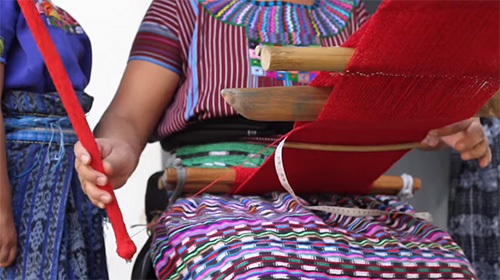
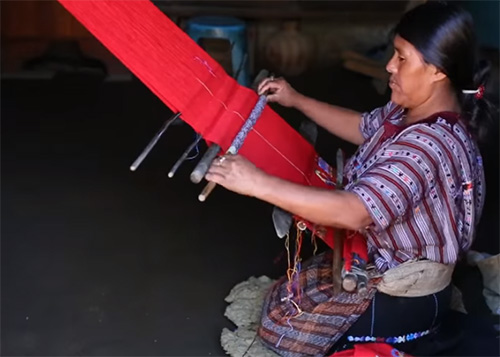
Process of weaving on a backstrap loom
My name is Erin Kökdil. I came into this story a couple of years ago when I first began working with a Fairtrade Organization in Guatemala, beginning nothing more than with a few simple questions. After I had requests from customers who use huipiles I began to explore the topic. What I discovered has forever changed the way I think about recycling huipiles. My hope is that this might change the story for you.
Focused in the Western Highlands of Guatemala, I set out to investigate this story. I wanted to speak directly with individuals who are connected to this issue. I first met with Lucia Jimenez, a social cultural anthropologist who has been studying this topic for the past two years.
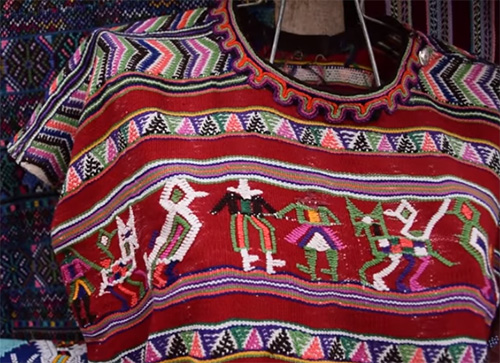
Sample of traditional Maya weaving
“I have always had a personal interest in weavings, not just the way in which they are created, the designs and aesthetics, but also all the cultural significance that these textiles have. The huipil is a garment that is part of the traditional dress of the indigenous Maya woman whose roots date back to Pre-Hispanic times”, says Lucia Jimenez.
“For me, the meaning of a huipil is very special, not only in my culture, because it is part of my culture and represents where I am from. If I go to another municipality, I represent Chichicastenango”, comments one of the Guatemalan craftswomen.
“In my case, I don’t want to lose this practice. I continue to wear huipiles because it is part of our culture, we value it because we, as women, are the ones who make the huipiles”, adds another young artisan.
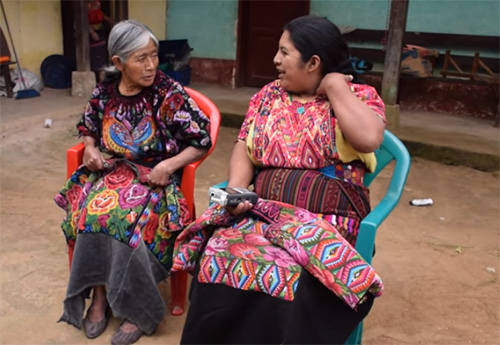
Guatemalan artisans with their huipiles
“It is the art that our ancestors have left us, they have given it value as their traditional dress. Today, there are very few women who continue to wear traditional dress. I want to give it the value it deserves”, says another craftswoman.
“The backstrap loom is a type of technology that is used to weave that has been used since Pre-Hispanic times. Backstrap weaving consists in a series of weaving sticks of different sizes that they use in a certain way to organize thread both horizontally and vertically”, adds Lucia Jimenez.
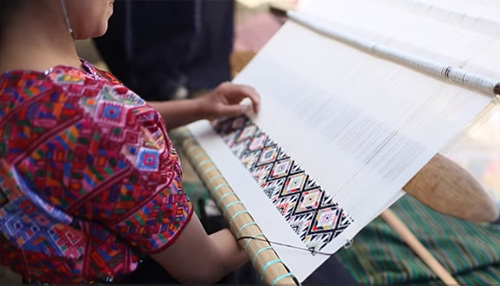
Process of weaving on a backstrap loom
“We wind the thread into balls, as the first step in the process, and after winding it, we put it on the warp board, and after that, we prepare it for use with the weaving sticks. And then we start to weave”, the artisan explains the process of weaving huipiles.
“Based on the techniques that women learn starting when they are little girls, they create distinct types of weavings and they use a very wide range of techniques”, says Lucia Jimenez.
To finish one huipil – and each one is made up of three parts – it takes from several days to about 6 months, 6 or 8 hours of work every day. It depends on the design and skill of the artisan. They start from the main three parts (the central one and two identical pieces on the sides). Then, they make narrow bands that are sewn to the places where the main parts are connected – these bands are like borders. The embroidering of the neckline is next, after which go the sleeves.
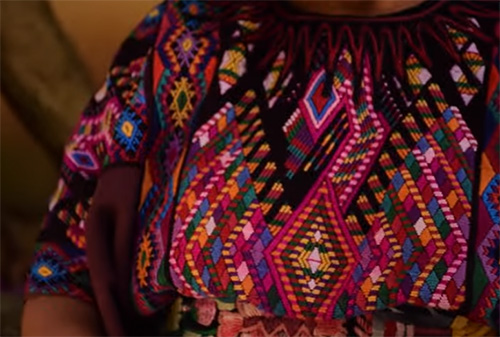
Sample of traditional Maya weaving
The intricacy of creating a huipil cannot be overemphasized and it is literally apparent in a level of detail and quality. The women I’ve spoken with and come to know, have put such great efforts in their huipiles. However, a traveling phenomenon that I witness as a professional working in Fair Trade, is the employment of used huipiles and a way they are marketed.
“So it’s using the used huipiles to create new products, like bags, coinpurses, wallets, backpacks, etc. Within this type of market that has emerged, many businesses that sell this type of products made with the used huipiles promote the products as first, Fair Trade, when in reality, a lot of times they aren’t, and secondly, as eco-friendly as they’re “recycling”. And if one thinks of the concept of recycling, reusing something that no longer has any use, it’s not that easy, as these textiles continue to be used within the communities”, Lucia Jimenez comments the using of used huipiles.

Sample of traditional Maya weaving
“It’s not really recycling because there are things that are still new, that the people can still use in a lot of different ways, but for certain needs, these individuals must sell their huipiles. They believe that their huipiles lose value. There are older traditional huipiles that are difficult to find today due to the fact that there are mountains of used huipiles for sale, and the people are practically giving away their huipiles for a very low price”, complains one of the artisans.
“What I have found is that there is a group of women that travel through all of Guatemala, and go to different towns, and knock on the doors of different homes, asking if they have used traditional clothing that they wish to sell. If the person has something they wish to sell, they get it and show it to the buyers. The women, or buyers, then choose what they wish to purchase”, continues Lucia Jimenez.
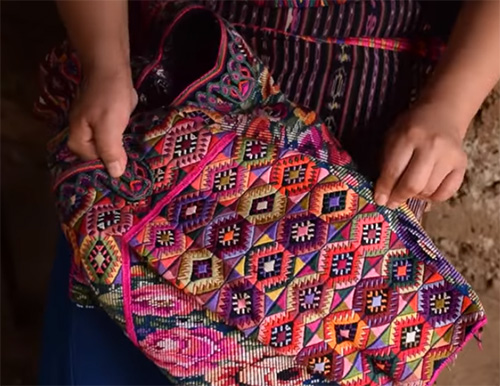
Sample of traditional Maya weaving
“If I sell this huipil, I have to sell it for at least 200 quetzales. But if they were to come right now and ask, “do you have a huipil for sale?” And out of need, for example, for my son’s education or if my baby is sick, I would offer my huipil and get only about 30 or 50 quetzales. While I have my need, I’m going to sell it regardless”, one of the craftswomen explains the problem.
“The people don’t offer a fair price when one wants to sell their huipil. They offer 8 or 6 quetzales. And with these prices, what can I buy with that? But I still must sell it anyway”, says the elderly artisan.
These buyers accumulate huipiles from throughout Guatemala and they take them to markets to sell, in general.

Mountains of huipiles sold by weight
“We seek this type of traditional clothing by going house to house because there are people who sell their clothing due to need, due to poverty, reasons like these that women must sell their clothing. There are husbands that do not support their families. And for that reason, sometimes women will sell their clothing because they do not have money to feed or doctor their kids”, comment women at the market who make business on selling huipiles.
Those who buy at these markets are broken down into various types. For instance, there are people who buy used clothing to use it themselves. It is done mostly by people from the rural towns, by people who are poorer. Then, there are people who sell used clothing to tourists. They go and buy the garments that are in the best shape. Then, they sell it for a higher price – that’s how they earn a living. Also, there are bigger businesses that buy the clothing by weight. This is what is used to make bags, wallets, backpacks, etc. with folk Guatemalan designs and patterns.
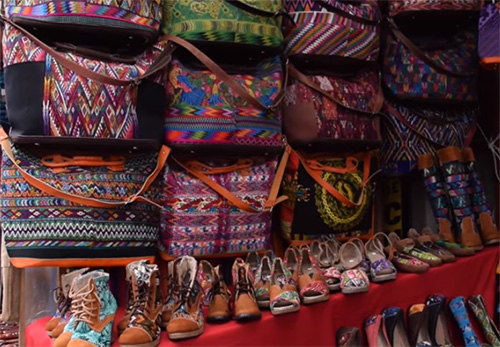
Accessories made from used huipiles
This current market demand has impacted the lives of thousands of indigenous women in Guatemala. A practice that is often marketed as ethical and fair trade has, in truth, greatly contributed to the devaluation of backstrap weaving and the exploitation of these women.
“I was impacted greatly by a small town I visited that was very poor. Every house that I visited, the story was the same. Women, who were living in extreme poverty, sold their clothing to people who pressured them into selling their clothing, so they sold their clothing, for 1 to 5 quetzales. That was the most that they paid these women, to rid themselves of something that still functioned to wear”, relates Lucia Jimenez.
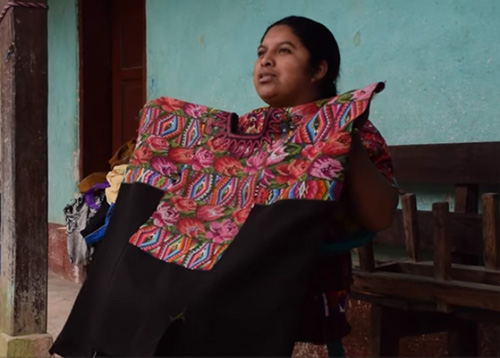
Sample of traditional Maya weaving
“Where has this come from? Why do they believe that their wearings aren’t valuable? I went to Nebaj, Cotzal, and Chajul to learn more. We saw the problem so great among these women, that they no longer value the traditional dress. It’s for this reason that we have lost the awareness of how valuable this work is. If we continue in this business of selling mountains of huipiles, we are going to lose our identity. The 22 states in Guatemala have their own identity, as demonstrated by their unique huipil. We need to realize that if this exploitation continues as is, we will lose our identity. We would begin to use substitutes to traditional dress, which are t-shirts, blouses. We would no longer have our traditions, we would lose our culture. And as I have said, Guatemala is known because it is multicultural, multilingual, and multi-ethnic. We would lose all of that in my opinion”, explains one of the artisans.
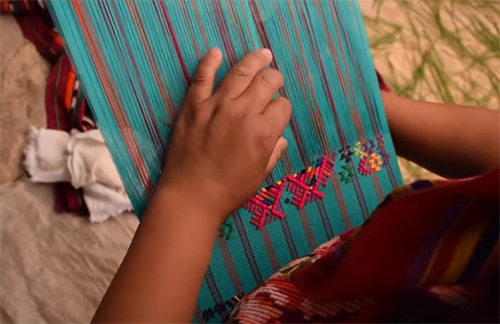
Process of weaving on a backstrap loom
“The intention of this study is not to criticize but to inform on a situation that probably most people do not know very much. More than that, show the individuals that are interested in helping that there is a way to help. They can go to these communities and speak with these women that are more than willing to work with these types of products, they enjoy this work, and it would be something that could truly impact in a positive way the lives of these women”, says Lucia Jimenez.
This is a story about huipiles. This is a story about exploitation and opportunity. My hope is that this might change the story for you.
“My huipil is from Santiago Atitlan. I like to wear it a lot because it carries a lot of knowledge from our ancestors, and I want to value what they did and continue to do to improve their quality of life at home”, says one of the young artisans.
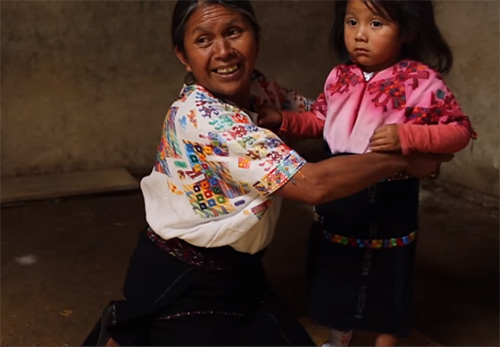
Local Guatemalan people wearing traditional clothing
“My huipil represents the art of the indigenous Maya woman. It represents the strength of women”, says another young weaver.
“My huipil is how I represent myself as a woman, a worker, a fighter. That’s how I represent myself as a Maya woman”, adds another craftswoman.
“My huipil has a cultural value and therefore, deserves a fair price”, says one of the Guatemalan artisans.
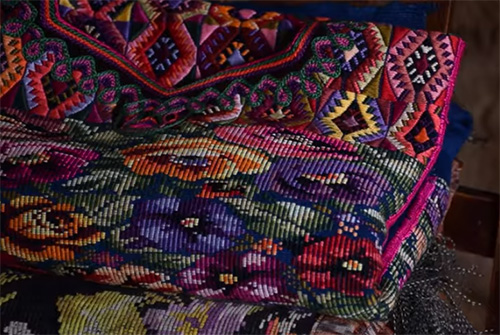
Sample of traditional Maya weaving
Read also: Traditional blouse of Guatemala. Maya women weave their folk clothing on backstrap loom
(c)


